Have you ever wandered what a geisha is? How popular they are in Japan, how to recognize a real one from someone just dressed like one?
Well look no further.
Today we’ll be uncovering all the mysteries, beauty, culture, and tradition tied to the image of geisha and maiko.
Geisha can be found all over Japan, but you have a very high chance of seeing one (or many) especially when visiting the old capital city of Japan, Kyoto. Kyoto is, in fact, still the cultural and historical capital of the country, and, to this day, is one of the places where you can experience Japanese tradition in its fullest, but let’s go in order.
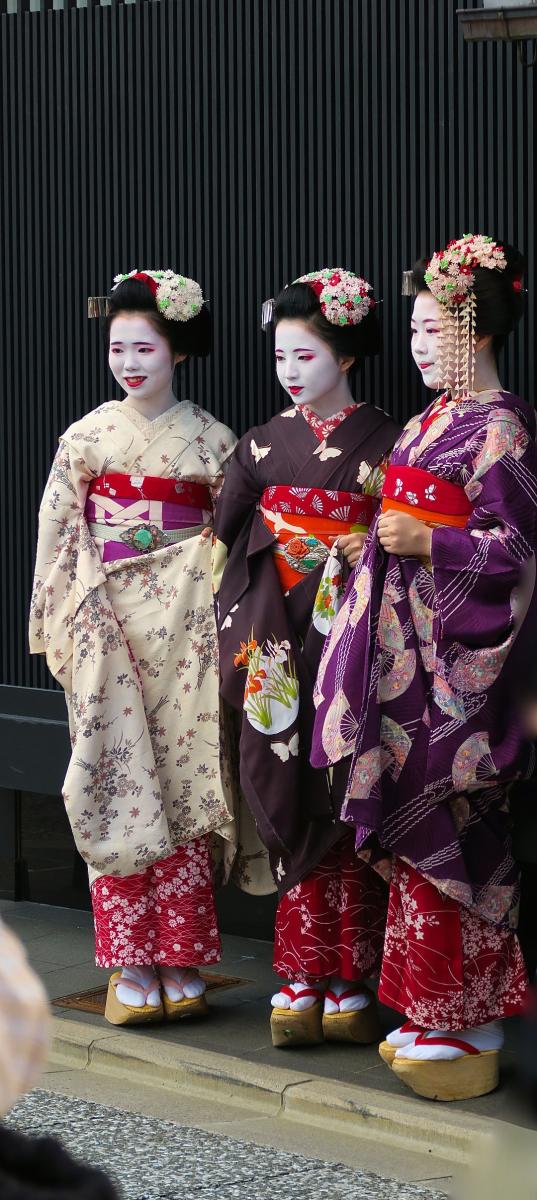
What are Geisha, Geiko, and Maiko?
The word geisha is composed by the kanji (Chinese characters used in the Japanese language) 芸 (gei - meaning “art” or “entertainment”) and 者 (sha – meaning person). Their name very much reflects their role in the history of Japan, as well as in modern times.
There is usually some confusion when reading or learning about geisha culture because oftentimes they are also referred to as geiko. The two words actually are two ways of referring to the same thing. The term geisha is used in Tokyo (and therefore it is the standardized way of pronouncing Japanese language), while geiko is the term used in Kyoto.
The reason why “geiko” may be as heard of as “geisha” is because of the total estimated 1000-2000 Geisha now present in Japan, the vastest majority are in Kyoto.
A maiko is essentially a geiko in training, and these young women will have to undergo seriously strict training before becoming full-fledged geisha (more about this later).
A geisha is an entertainer trained in the arts of dancing, singing, playing instruments, and conversation and hospitality.
It’s important to dispel a myth surrounding these performers: geisha and maiko are not sex workers, despite the widely believed misconception that the words geisha and prostitution go hand in hand.
Part of the misunderstanding derives from misrepresentation of these artists in movies and literature. Some of it lays on lack of available information, and most of it is latched to the history of Japan.

The history of geisha
Pinpointing the origin of geisha in Japan is complicated because there wasn’t a clear-cut rise to notoriety of these entertainers during the history of the country.
Their roots may dig as deep as the 7th century's saburuko female entertainers and the 13th century's shirabyoshi dancers.
Some saburuko girls sold sexual services (at that time prostitution in Japan was legal). In 1617 the Shogunate made prostitution legal only in the so-called “pleasure districts”, and it would require establishments and working women to be licensed. Among those women were the tayuu, high class entertainers who were experts in dancing, acting, and who also sold sexual services. It’s at the beginning of the 19th century that entertainers started calling themselves “geisha”, and soon there was a very clear distinction between them and working girls. In order to protect the business for which they worked (okiya, ochaya) geisha and geisha in training were forbidden from selling sex.
From that moment on, the role of geisha as entertainers in Japan became more and more distinct and separated from that of prostitutes, at least until the end of WWII.
During the war, because of financial issues, and later because the many changes that followed the defeat of Japan in the war, many geisha ochaya (tea houses) were forced to close down.
Simultaneously, the country saw a sudden surge in the presence of American military on the territory. Soon, many businesses capitalized on the appeal that “traditional Japanese girls” had over the foreign occupants. For these reasons many women dressed as geisha (without actually being geisha) and sold sex to American soldiers for years to come.
Although there aren’t today as many geisha as there were centuries ago, these entertainers are still a very sought after form of entertainment in Japan. As mentioned earlier, most of them are located in Kyoto (largely in Gion and Kamishichiken), but some areas of Tokyo (Shimbashi, Asakusa, Kagurazaka) also have a lot of ochaya.
The districts with a high presence of geisha are usually nicknamed hanamachi (flower town), and they are the best bet if you want to attend a show, or organize a private party, or even simply have the opportunity to catch a glimpse of a real geiko.
Very much like they used to, geisha today entertain their guests with traditional dances, music, conversation, and by being masters of hospitality. Their services can be extremely expensive, but one could book a few hours, usually over dinner, either in a tea house, or in a restaurant (usually a luxurious Japanese style restaurant called ryoutei).
How to become a Geisha
Becoming a geiko requires effort, dedication, and an enormous amount of practice. Originally geisha training started on average at the age of 10, but since the 1950's laws that regulated child labor, things changed and nowadays the training starts around the age of 15-18, and in Tokyo, occasionally, later.
To start with, a girl who aspires to becoming a geisha, will need to apply, just like they would for any other job, but, unlike most conventional professions, they will have to undergo a very strict screening.
The applicant must be of perfect mental and physical health. This is required because the training can be very arduous and straining.
She must be younger than 18 (or younger than 20 years old in Tokyo), unmarried and no taller than 165 cm.
For younger girls, parents must consent to the training and be present during the interviews.
The applicant must be physically strong and willing to undertake a strict dietary and training regimen.
Finally, the aspiring geisha must have strong and healthy hair and skin, and must be not too skinny or overweight.
These rules can change depending on the okiya.
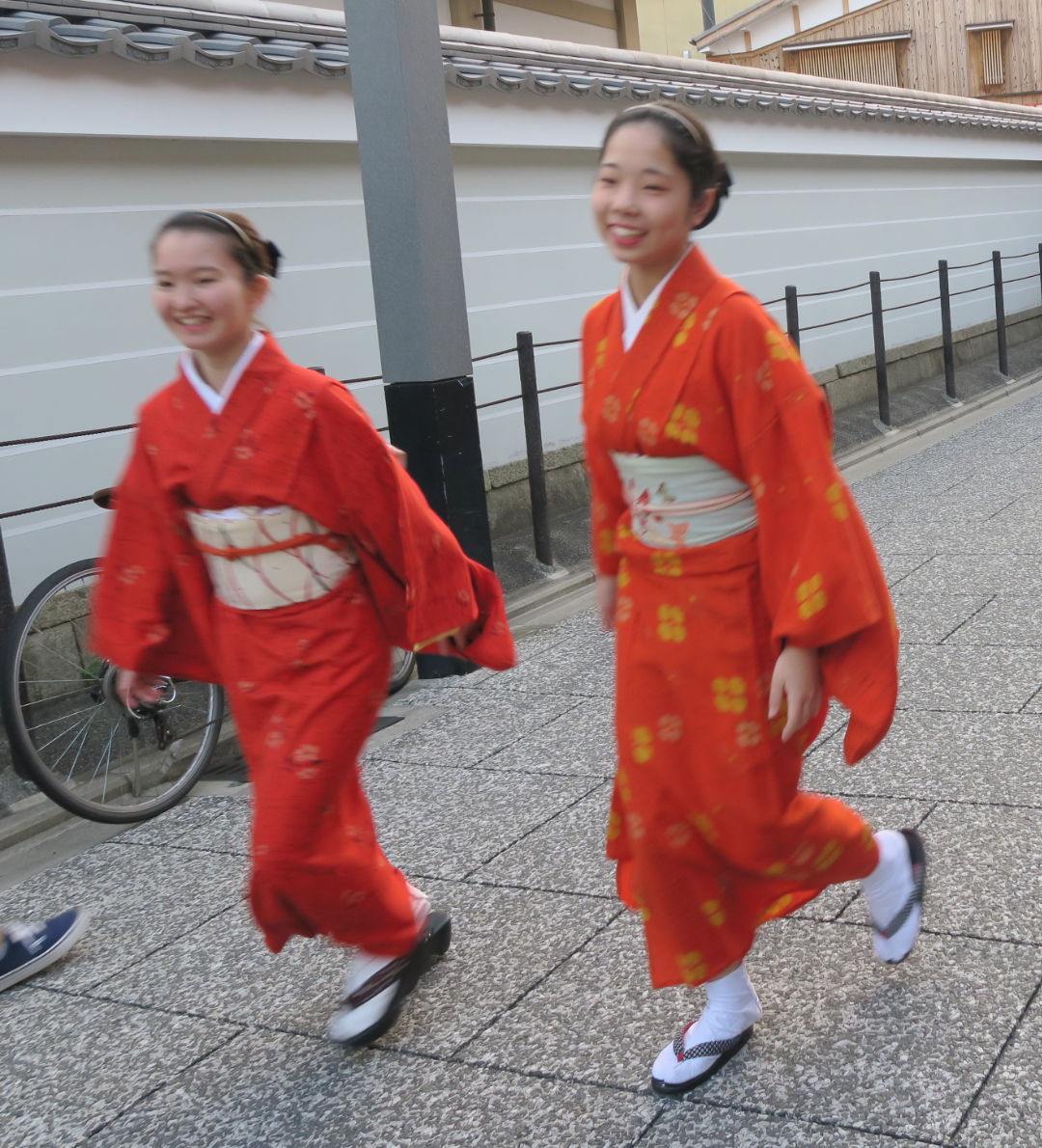
Once the girl is accepted, she will become a shikomi. A maiko is a geiko in training, and a shikomi (known as shikomi-san) is a maiko in training. The training period to become a maiko lasts 1-4 years. During this time the shikomi will attend nyokoba (a vocational school for aspiring geisha to learn a variety of skills). They will practice instruments like the shamisen, the fue (a bamboo flute), and the kotsuzumi and the shimedaiko (small percussion instruments).
Aside from that, the shikomi will help with chores to maintain the okiya, they will shadow and function as assistants of geisha, and will perfect their demeanor, and proper conversation skills (such as talking to guest, or older people).
The training of shikomi and later of maiko is overseen by the okaasan (lit. mother), usually also the owner of the okiya, but they will also have a full-fledged geisha mentor whom they call oneesan (sister). By doing so, the apprentices will be able to learn by watching, gaining real-life experience.
At the end of this training period, the shikomi will participate to misedashi, the official debut ceremony for a soon-to-be maiko. The girls will wear distinctive clothes (a black kimono) and makeup (especially recognizable because of three white pointed makeup decoration on the nape of her neck).
The most important part of the ceremony is the ritual of sansakudo (three-cup-exchange) during which she will exchange cups with a senior maiko, her mentor, and another geisha.
Maiko and how to distinguish them from geiko
Becoming a maiko is already a huge accomplishment but it’s only a step towards becoming a geiko. They do look quite similar to one another, though, unless you’re very familiar with the makeup, hair and clothing.
Aside from their title there are many differences between maiko and geiko.
The first, and sometimes the most evident is their age. A maiko will always be younger. In order to be a maiko, generally, you can’t be older than 20.
Another major difference lays in their iconic hair.
The hair a geiko shows is thick and black, but it’s a wig, while the hair of a maiko is the girl’s own hair styled in a similar fashion. Furthermore, maiko will usually wear ornate and showy hair gadgets, while geisha will have ornaments that are less conspicuous.

Maiko-san (foreground); Geiko-san (background)
Their iconic makeup may look very similar at glance, but after a closer look, you will notice that while both makeup styles include the iconic thick white makeup on their face, the maiko will have a prominent red blush on their cheeks to accentuate their youth.
Another more visible difference is in their lipstick. Maiko paint only their bottom lip red, or both lips with a thin red line (if the maiko is a senior). Geiko lips are instead both fully red.
Maiko may also have red eyebrows, while geiko do not color their eyebrows.
You can usually spot a maiko simply from her footwear (tall and bulky sandals).
Some more hard-to-spot differences can also help you distinguish a maiko from a geiko, in particular the length and size of the sleeves of the kimono they wear.
Almost nothing in a maiko's clothing is purely aesthetic. The shoes they wear are supposed to train them to walk properly accordingly to geiko standards. Similarly, the sleeves of their kimono are longer, larger and heavier, serving the purpose of forcing them to put more effort and perform the correct movements when dancing, playing instruments, engaging in games with guests, or serving drinks.



Why do some girls today still want to become geisha?
Many girls are attracted to the geisha culture for the aura of culture and romanticism that surrounds them. Another no-small reason is that geisha in Japan are treated and considered as (and in some cases are) celebrities.
The life of a geisha can be a fulfilling and profitable one, but while these reasons are enough to convince some girls to start their apprenticeship, they tend to not be enough to stick through the severe training.
Many girls practice performance arts since a very young age, and becoming a maiko and subsequently a geisha is almost the most logical step forward (and that’s why some drop out of high school to pursue that path).
In other cases, knowing that the future of a geisha can potentially be very bright, some families pressure their daughters to become maiko. Unfortunately though, in order to become a geisha, the girl will need a lot of patience, drive, and strength, which are hardly achievable unless there’s a real “calling”. So, there are some cases of girls sneaking out of their okiya to go back home.
Another appealing aspect when it comes to the life of a geisha is that these artists travel a lot, not only within Japan, but all over the world for shows and even private parties.

Can a foreigner aspire to become a geisha?
The short answer is yes.
It’s not impossible for a foreigner to become a geiko, but the path to becoming one is even harder than that of their Japanese counterparts.
The training and selection would be very similar, but the girl would also have to battle against traditional standards that are very hard to break through.
There are currently seven foreign geisha in Japan, none of whom in Kyoto, the city with the most traditional and longest lasting geiko culture.
As a foreigner, you would be expected to be able to perform and speak exactly the same as a Japanese girl going through the training, so even being fluent in Japanese is probably not enough (you’d have to achieve a native-speaker level of language).
How and where can I see or meet a geisha? How do I find a show or an event to attend?
Interacting with a geisha or maiko today is the ultimate way to experience omotenashi, the Japanese concept of both visible and invisible hospitality.
Because of their role as entertainers, geiko appear in many kinds of shows. The most common ones are performances of dance and music, but they are also known for beautiful theatre plays based on acting, singing, and dancing while accompanied by traditional instruments. These plays are usually a take on popular Japanese legends and stories and some of them have been performed for centuries. One such performance is held during the Kitano Odori in Kamishichiken, Kyoto (March to April).
Geisha also appear and participate in some festivals and parades, especially in spring and summer, such as the Baikasai Plum Blossoms Festival (February, Kitano Tenmangu in Kyoto), or the Yasaka Shrine Setsubun Festival (Kyoto).
The festivals are free to attend, but keep in mind that they often draw very large crowds. The theatre plays, on the other hand, require the purchasing of a ticket.
If you’re interested, it would serve to plan ahead, and occasionally get some help, as most of the websites that sell tickets are in Japanese only (also, in most cases, you won’t be allowed to take pictures or videos of the performance in the theatre).
If you’re interested in a more up-and-close experience, that is also a possibility, but in most cases more complicated.
Being a foreigner will not influence your chances to book a private dinner, or show, but if you can’t speak Japanese you will find it hard not only to book a show, but also to communicate with the maiko and geisha that will be entertaining you.
Another thing to consider is that, by and large, a private booking with one or more geishas including dinner, dances, music, and games can be extremely expensive, especially if they are held in a restaurant or ryokan (Japanese traditional hotel), or in the geisha tea house.
Maiko and geiko in Kyoto
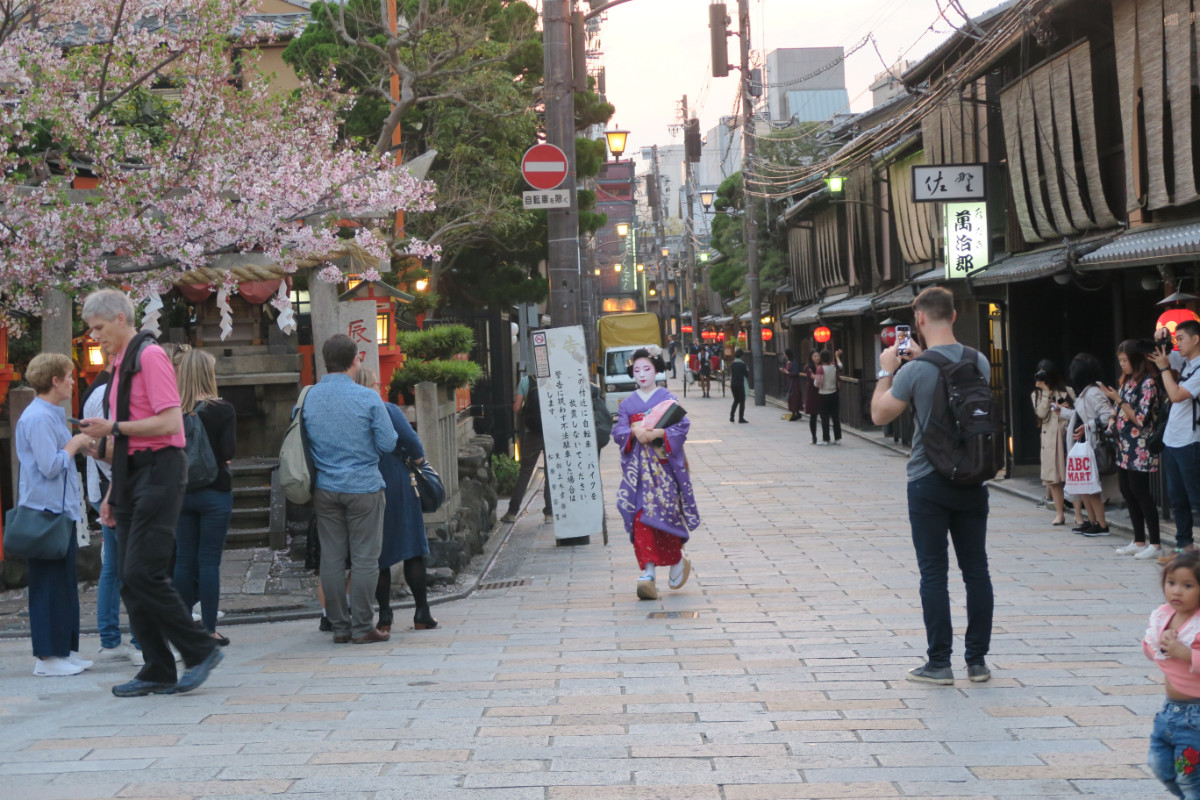
Kyoto is indisputably the largest stronghold of maiko and geiko culture. Almost all of the geisha in Japan live in Kyoto and it’s also your best chance of catching shows and festival where these artists performs.
Kyoto is also where you will almost certainly see a maiko or geisha seemingly casually walking the streets of the city.
Being a geiko in Kyoto is as close to stardom as these entertainers can get and several of them are actually very well-known faces, appearing on a number of articles, billboards, news and more.
There are several areas in Kyoto where there’s a high concentration of geiko tea houses, but the ones that rise above the others are certainly the extremely popular district of Gion (as well as the neighboring Ponto-cho), and the oldest and most traditional geiko district of the country Kamishichiken.
Gion is an extremely popular tourist area, and you will likely walk amongst a sea of people, while Kamishichiken is a less popular area among tourists, although equally as beautiful.
If you visit one of these districts, you’re almost guaranteed to see one or more maiko and geiko, and you surely will want to take some pictures, or even maybe exchange a few words with them, so how to do that without being disrespectful?
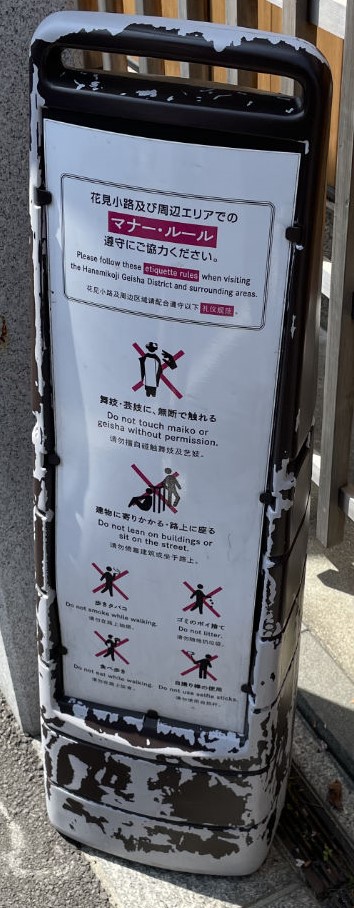
How to behave when interacting with a maiko or geiko
Most of the times, when meeting geiko and maiko in the street, common sense is all you need to avoid appearing rude.
If you see a geiko walking in the street you should assume she’s working or going to work. As much as you wouldn’t ask a taxy driver to take a picture with you while they are driving, it’s best to avoid doing the same with a geiko.
While it is true that taking pictures of random people without asking is considered to be impolite in Japan, these artists expect to be the subject of attention and you should not feel like you’re invading their privacy, should you want to snap a picture from the distance. That being said, it’s best to do so without blocking their path, or while standing too close to them.
While to most this may seem like obvious behavior, especially in the district of Gion in Kyoto, things have gotten so out of hand that the city put signs in some of the most popular streets of the neighborhood asking people to avoid physically stopping maiko and geiko. Similarly, the signs will inform that you shouldn’t take pictures of geiko and maiko from up close, or grab them by their kimono.
If you’re interacting with maiko or geiko during a private or public event, things are a little bit different.
Geiko appear during festivals knowing there will be hordes of professional or amateur photographers as well as a number of tourists. That’s a good time to take all the pictures you feel like taking.


When it comes to private events, how should you prepare?
Well it depends on the kind of event.
If you’re attending a formal dinner, or visiting the geiko’s teahouse, while not required, it’s appropriate to dress partially formally. We are not talking suits and evening dresses, but avoid shorts, baseball caps, or similar clothing, if possible.
When you’re interacting privately with a geiko there are some etiquette rules that is always best to keep in mind.
While their training made geiko masters of entertainment and interaction, they are equally as trained into maintaining an aura or mystery. For this reason, they will try to avoid answering questions that are too personal, and will avoid crossing social boundaries between host and guest.
Other than that, be respectful and have fun! This is a rare opportunity and an awesome experience.
What can I expect during a traditional private performance?
These occasions usually start with dinner and drinks and are then enriched by a number of performances and games.
Usually the maiko and geisha will play the shamisen or other instruments, and perform several dances (most notably the Nihon Buyo).
The night is not only an occasion to see these performers work from up close, but also an amazing experience interacting with them, and playing games with them.
There are many traditional drinking games that maiko and geiko play with their guests, some for two players and some for multiple players.
All you have left to do now is come to Japan and hopefully meet these skilled and beautiful traditional entertainers!



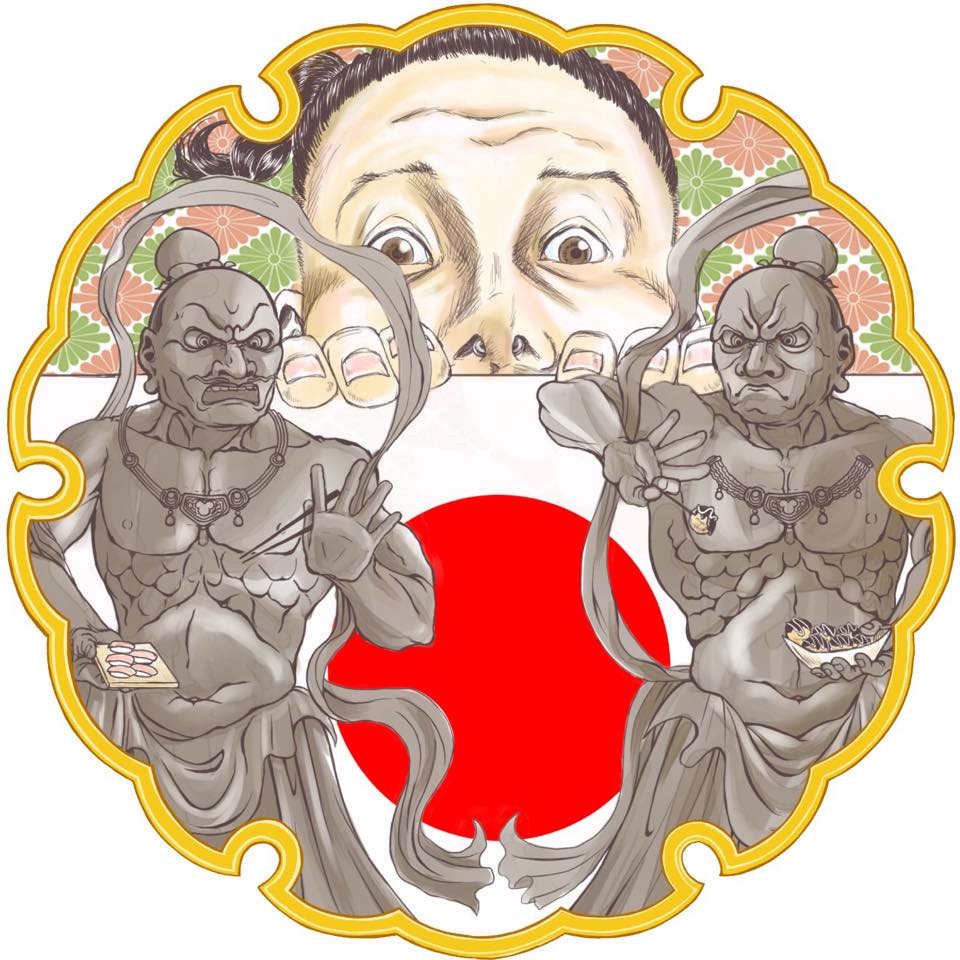


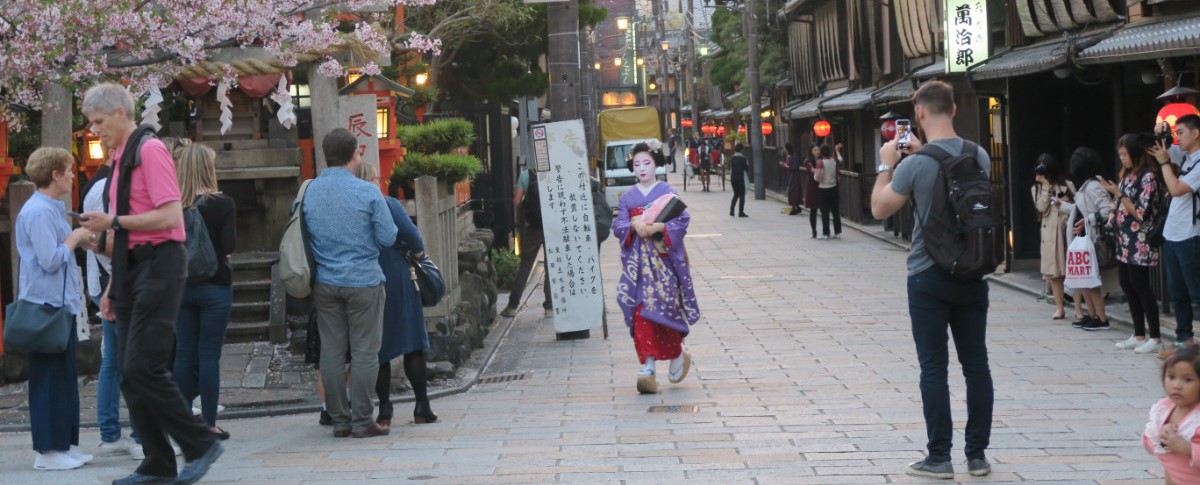



No comments